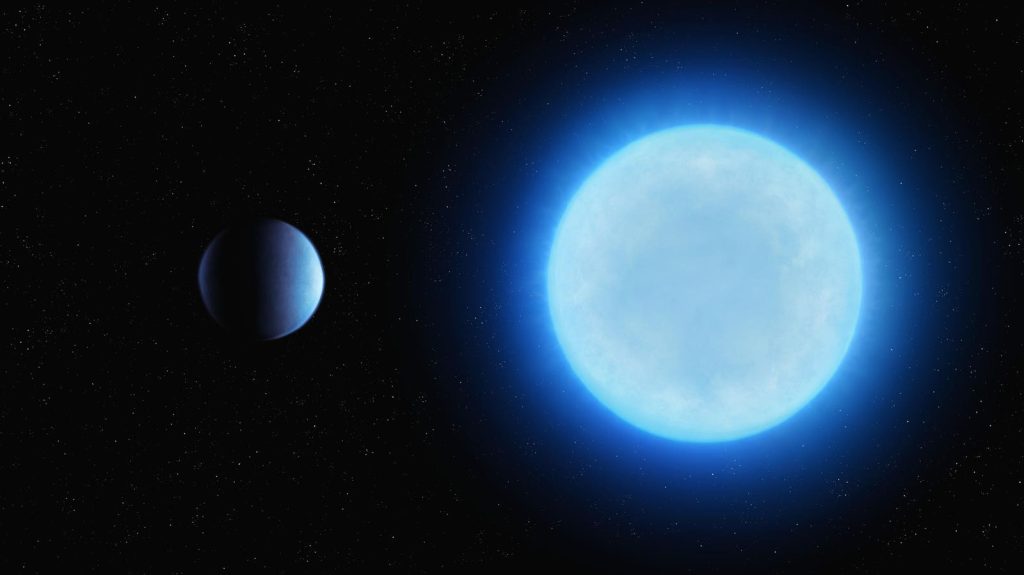In exoplanetary science, white dwarfs are usually only an afterthought. Most extrasolar planet hunters are too busy looking for an Earth 2.0 to give these hyper-dense stellar remnants much consideration but as endgame byproducts of stars like our own.
“A white dwarf contains roughly the entire mass of the Sun crushed into a volume the size of a rocky metallic planet like Earth,” Edward Sion, an astrophysicist at Villanova University in Pennsylvania, told me via email. “A white dwarf’s mass density is typically 10 million grams/cubic centimeter. The density of Earth’s iron-nickel core is only roughly 10 grams/cubic centimeter.”
Even so, white dwarfs are extraordinarily difficult to spot observationally and only in the last decade or so have we even been capable of looking for earth-like planets on extremely short orbits around these dim objects.
But white dwarfs are also important in understanding the history of our Milky Way.
“White dwarfs are the terminal evolutionary state of 98% of the roughly 200 billion stars in our Milky Way,” Sion writes in his recent book, Accreting White Dwarfs: From exoplanetary probes to classical novae and Type 1a supernovae. “They show us what the Sun will become in the future, the history of star formation in our Galaxy.”
How many planetary systems have been found circling white dwarfs?
Two confirmed cases are WD1856+534 with a Jupiter-like planet with an orbital period around the white dwarf of only 1.4 days, says Sion. The other case is WD1054-226 has an approximate distance between the planet and the white dwarf of roughly 2.5 million km (1.55 million miles), around 1.7% of the Earth-Sun distance, he says. The area will be habitable for at least two billion years, including at least one billion years into the future, says Sion.
A team using the James Webb Space Telescope’s mid-infrared instrument also recently reported the discovery of two directly imaged, giant planet candidates orbiting the metal-rich white dwarfs WD 1202-232 and WD 2105-82. If confirmed, these would be the first directly imaged planets that are similar in both age and separation to the giant planets in our own solar system, the authors write.
Their findings were reported earlier this year in The Astrophysical Journal Letters.
As For Our Sun’s Future As A Red Giant?
Most white dwarfs are the end products of stars with masses between 1 and 8 solar masses, says Sion. Curiously, the model evolutionary calculations of the Sun show that it will lose about 40% of its mass during its evolution as a red supergiant evolving along what is called the asymptotic giant branch (AGB) of evolution, he says.
Evolution at that stage occurs with heavy mass loss in the form of stellar winds and super winds, says Sion. It is during this stage of heavy mass loss that a planetary nebula is ejected with the core of the red supergiant exposed to space as a newly born white dwarf or a pre-white dwarf emerges, soon to be a white dwarf, he says.
Would a civilization be able to survive around a white dwarf?
If the white dwarf is isolated, stable, with no interacting binary star companion, as it slowly cools over billions of years, says Sion. And if it is well behaved without damaging flares or magnetic storms like the Sun, he says.
But It Would Be Very Cold
Even if the planet is gravitationally locked so that it keeps the same face illuminated by the parent white dwarf, the opposite side would approach absolute zero, says Sion.
Could an earth-like planet that had intelligent life survive?
With advanced life and the availability of controlled nuclear fusion energy or a source of energy even more advanced, anything is possible to achieve limitless habitability, says Sion. Their presumed ingenuity would likely discover an alternate process for growing food, he says.
As For Light From The White Dwarf?
At a temperature of 4500 Kelvin, there would be optical light, but as the white dwarf cools over long timescales, the bulk of the radiation would shift to the far infrared, says Sion. And the optical flux received at the planet would be much lower, he says.
And once the white dwarf cools down below 1000 Kelvin or so, darkness would start to be a factor, says Sion. Eventually, the “daylight” on the planet would cease as the white dwarf releases all its thermal energy (heat) and cools to become what we call a black dwarf with a temperature near absolute zero, he says.
Read the full article here






